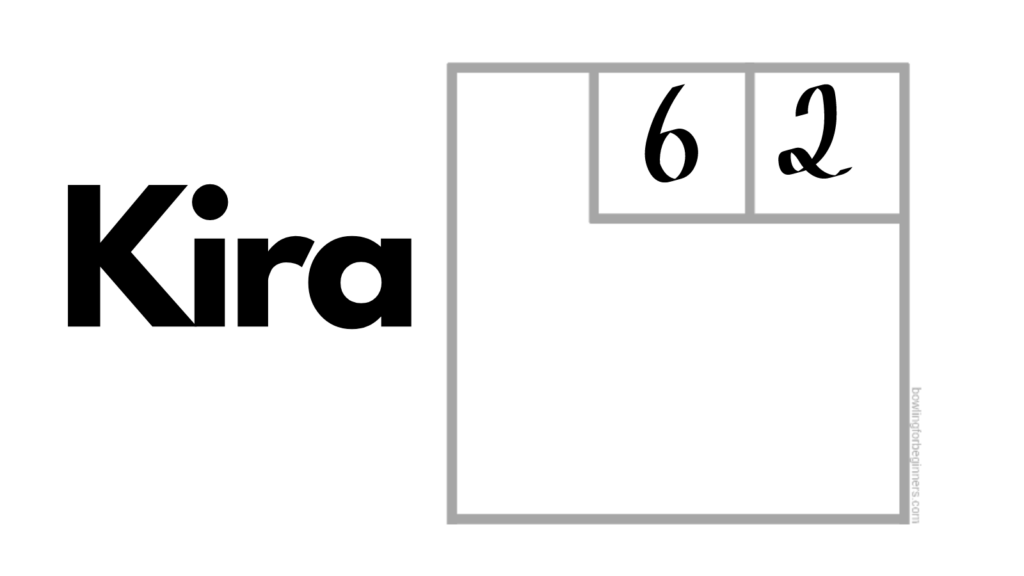
Computerized scoring systems are available in most modern bowling alleys, and knowing how to keep your bowling score is just part of understanding the basics of bowling.
How bowling is scored is fairly straightforward. But there are a few twists. You'll need to practice scoring individual frames to be sure you're keeping track accurately. Then sum up those frames as you go to figure out your ultimate score at the end of the game.
This article will walk you through how you keep a bowling score, frame by frame. We will explain the twists to help smooth them out. After reading this article, you'll better understand how your pins fall, and how your score is affected.
Contents
- 1 How Is Bowling Scored?
- 2 How To Keep Score In Bowling (Frame 1-Frame 10)
- 3 What does an X mean in bowling?
- 4 How Many Points Is a Strike?
- 5 What Does / Mean In Bowling? And How Are They Scored?
- 6 How Many Points Is a Spare
- 7 What is it called when you roll two strikes in a row?
- 8 How Do You Score Doubles In Bowling?
- 9 What Does '-' Mean In Bowling?
- 10 How Do You Score '-' In Bowling
- 11 What is it called when you roll three strikes in a row?
- 12 How Many Points Are 3 Strikes In a Row?
- 13 How to Score In Bowling For Dummies
- 14 Frequently Asked Questions Related to How Is Bowling Scored
- 15 Related Articles
How Is Bowling Scored?
Tenpin bowling is scored by an ongoing record/tally of knocked down pins from frame 1 to frame 10. Every pin knocked down is worth one point in that frame.
Strikes are worth 10 points plus the next two rolls, spares are worth 10 points plus the first next roll, and lastly, gutters are worth 0 points.
Let us further explain how strikes, spares, and gutter balls affect your score.
Key Takeaways
- Bowling Scoring Basics: Each pin knocked down equals one point. An open frame's score equals the total pins knocked down in two attempts.
- Strikes and Spares: A strike ('X') scores 10 points plus the next two rolls. A spare ('/') adds 10 points plus the next single roll.
- Special Terms: A "Double" means two consecutive strikes, and a "Turkey" represents three straight strikes. Strikes and spares affect subsequent frame scores, requiring strategic play.
- 10th Frame Rule: The 10th frame allows up to three rolls for a chance at extra points, which is critical for maximizing the game score.
- Scoring Practice: Understanding and practicing manual scorekeeping enhances game appreciation and strategy despite digital scoreboards.
How To Keep Score In Bowling (Frame 1-Frame 10)
Frame 1:
You scored (knocked down) 6 pins on your first roll and 2 pins on the second roll.
Your score for the first frame is 8.
Frame 1 is considered ‘open’ because you have remaining pins (leaving points on the lane).
Frame 1 6 (roll 1) + 2 (roll 2)= 8 points in Frame 1
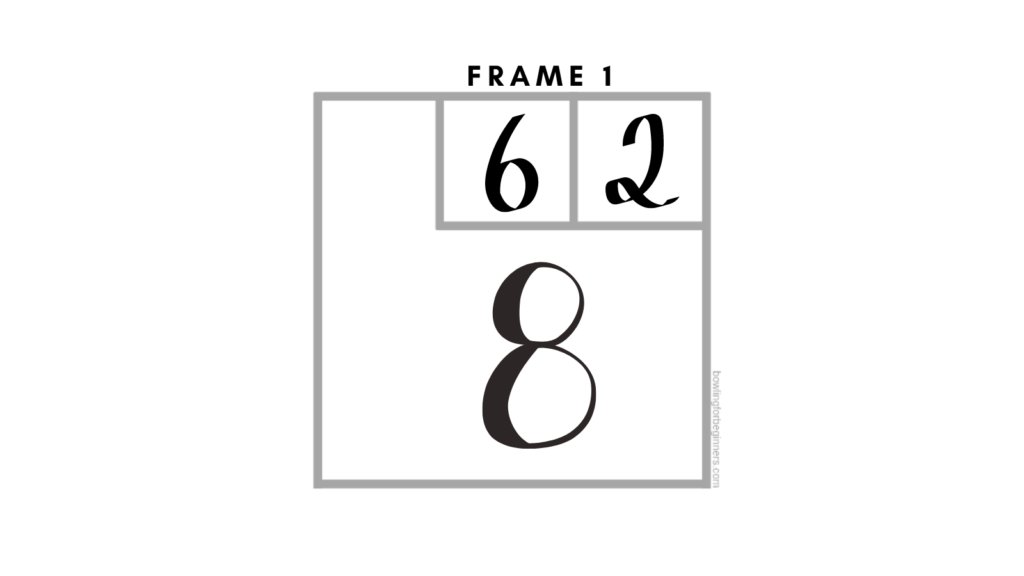
Frame 2:
In Frame 2, you knocked down all the pins, and an “X” appeared in your frame.
What does an X mean in bowling?
In bowling, an X means you scored a strike.
How Many Points Is a Strike?
For your score, you get ten points in the second frame, added to the first frame's 8 points. So, your holding score is 18 for Frame 2, plus any pins knocked down from your next two rolls are added to the holding score (18).
So, you'd need to roll two more times before you know Frame's 2 total points. These extra rolls are typically thought of as bonus points.
Since you rolled a strike (or if you’d rolled a spare) in Frame 2, it's considered ‘closed’. The are no additional points that could be earned from this frame.
Frame 1 (8) + Frame 2 (10)= 18 (holding) + next two rolls (? + ?)= ?
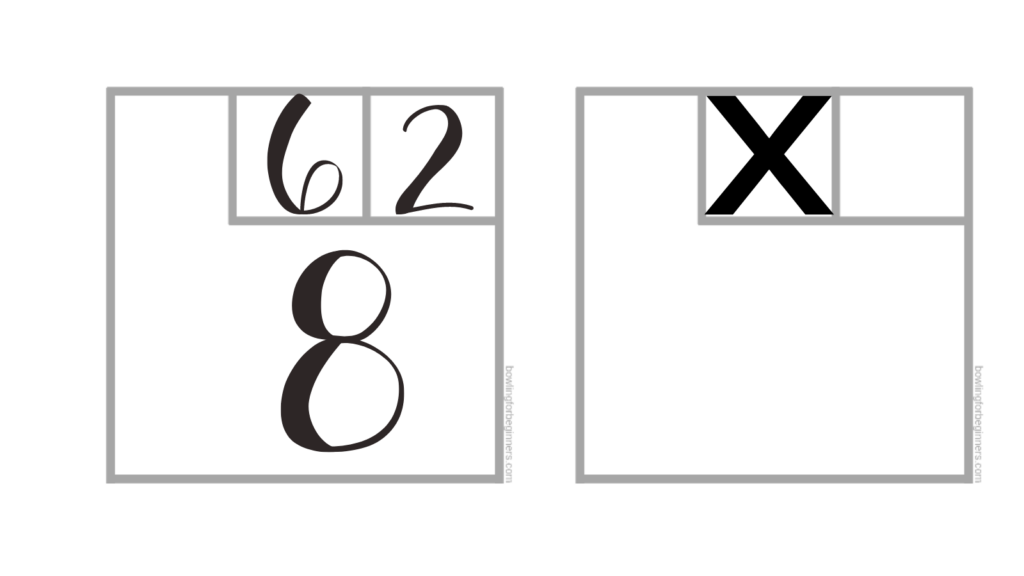
Frame 3:
In Frame 3, you roll a 3 first, then a 2.
Remember, Frame 2 is waiting for the next two rolls to get its total. Now the 3 pins from roll 1 and 2 pins from roll 2 are added to the second frame that's holding 18. In the example, the holding 18 is written off to the left, and the pins from the next two rolls are listed as well.
Frame 1 (8) + Frame 2 (10)= 18 (holding) + next two rolls (3+2)= 23 points for Frame 2
Now calculate Frame 3's points:
Frame 2 (23) + Frame 3 (3+2)= 28 points for the Frame 3

Frame 4:
In Frame 4, you roll a 5, and a '/' (slash) appears on your screen on your next roll. But you knocked down all the pins.
What Does / Mean In Bowling? And How Are They Scored?
In bowling, a slash or an '/' means you scored a spare.
How Many Points Is a Spare
The scoring of a spare is very similar to a strike, with a slight difference. Just like a strike, you add ten points. But the difference is instead of adding the points from your next two throws, you only add the points from your next throw.
Because you got a spare, to get your score for the fourth frame, you’ll need to roll the first ball in the fifth frame. Remember, you are holding 38 points in Frame 4.
(Frame 3) 28+ (Frame 4's spare) 10 + (Frame 5 first roll only) ? = ? is your Frame 4 score
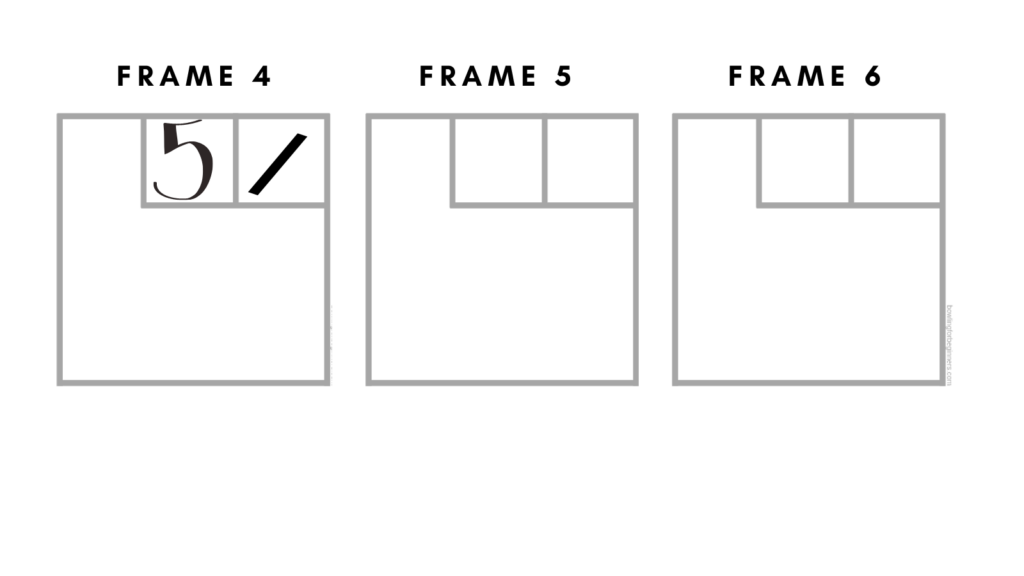
Frame 5:
In Frame 5, you roll a strike 'X'.
Remember, a strike is 10 points plus the next two rolls. So in order to know your Frame 5's total score, you must roll the bowling twice.
But first, let's finish the calculation for Frame 4.
Remember, you only needed the points from the very next roll, which happens to be a strike and is worth 10 points. So add 10 to Frame 4's holding score of 38.
Frame 4 (38)+ next roll (10)= 48 points for frame 4
Now, let's move on to Frame 5.
Remember, in the fifth frame, you rolled a strike. So, to calculate the total score for Frame 5, you must roll two more times.
Frame 4 (48)+ (Frame 5 (10)+ roll 1 ? + roll 2 ?= ? points for frame 5
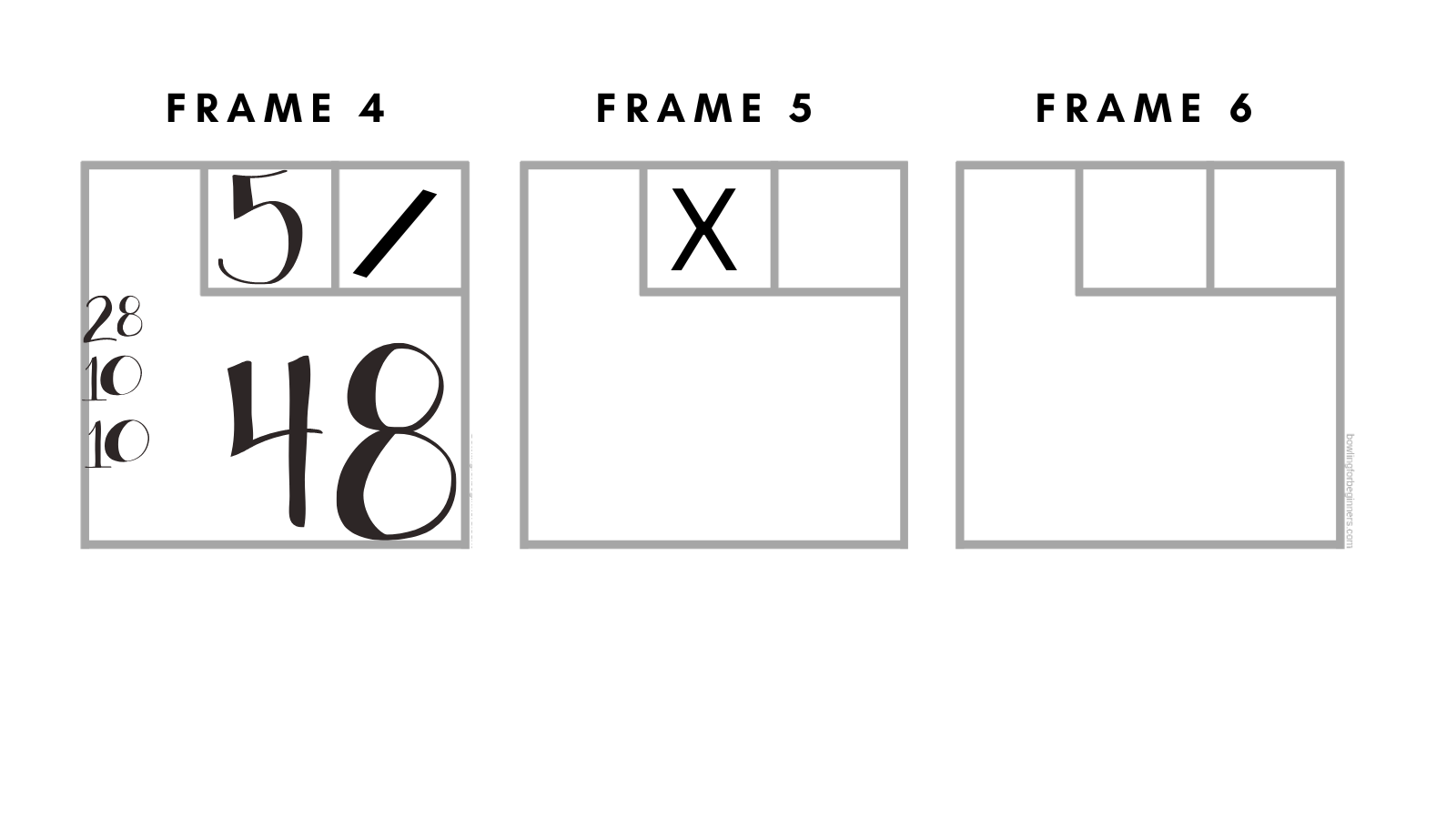
Frame 6:
In Frame 6, you knocked down all ten pins again!
What is it called when you roll two strikes in a row?
In bowling, when you roll two strikes back to back, it's called a Double.
How Do You Score Doubles In Bowling?
Scoring Doubles gets a wee bit complicated, but we tried to make the logic as simple as possible. As mentioned above, one strike is ten points plus the next two throws. While a double is worth 20 points, 10 points for each strike, plus the next two rolls.
In our example, in order to know your score in Frames 5 and 6, you must roll one more time.
Frame 4 (48)+ Frame 5 (?)+ Frame 6 roll 1 ?+ roll 2 ? + Frame 7 roll (1) + roll (2)= ? points for frame 6
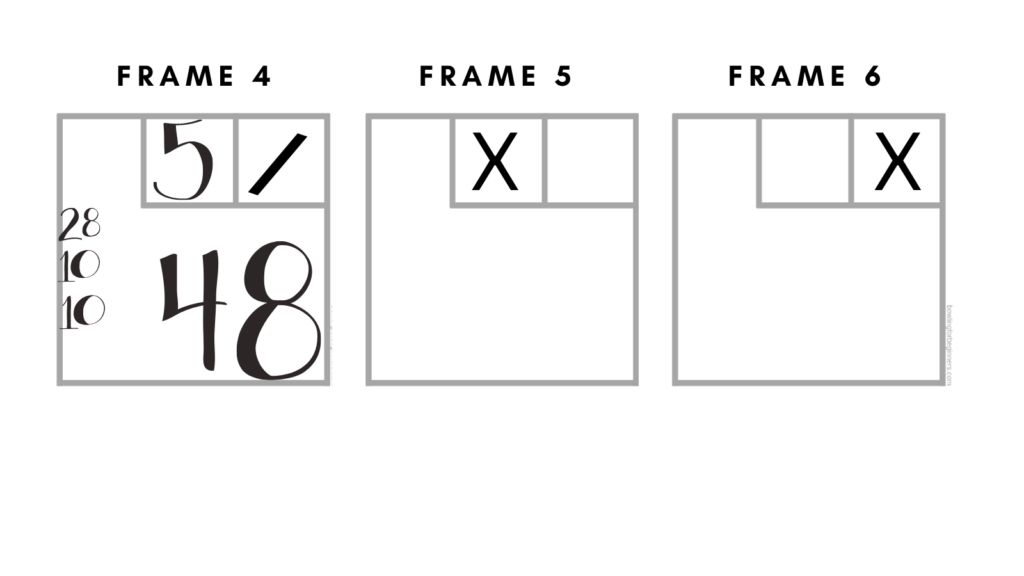
Frame 7:
On your first roll for Frame 7, you knocked down 1 pin.
Remember, from frame 5, you had a strike and needed two more rolls to tally the score: Frame 6 was 10 points (roll 1), and Frame 7's was 1 point (roll 2).
Calculating Frame 5 score:
Frame 4 (48)+ Frame 5 (10)+Frame 6 (10) roll 1 +Frame 7 (1) roll 2= 69 points for Frame 5
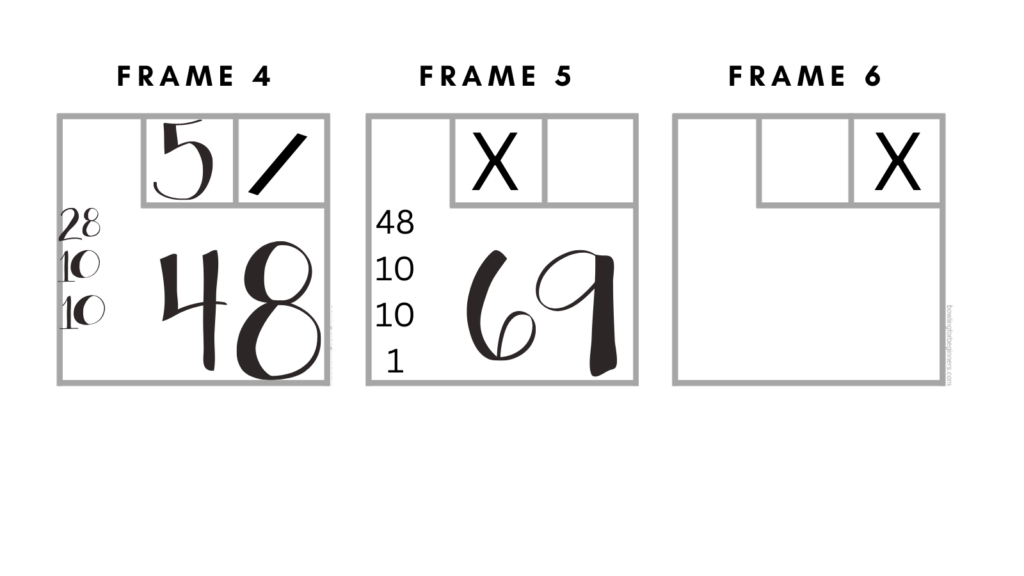
Moving on and finishing your last roll in Frame 7, you knock down 4 pins.
Now you can calculate the total score for Frame 6:
Frame 5 (69)+ Frame 6 (10) + Frame 7 first roll (1)+ second roll (4)= 84 points for Frame 6
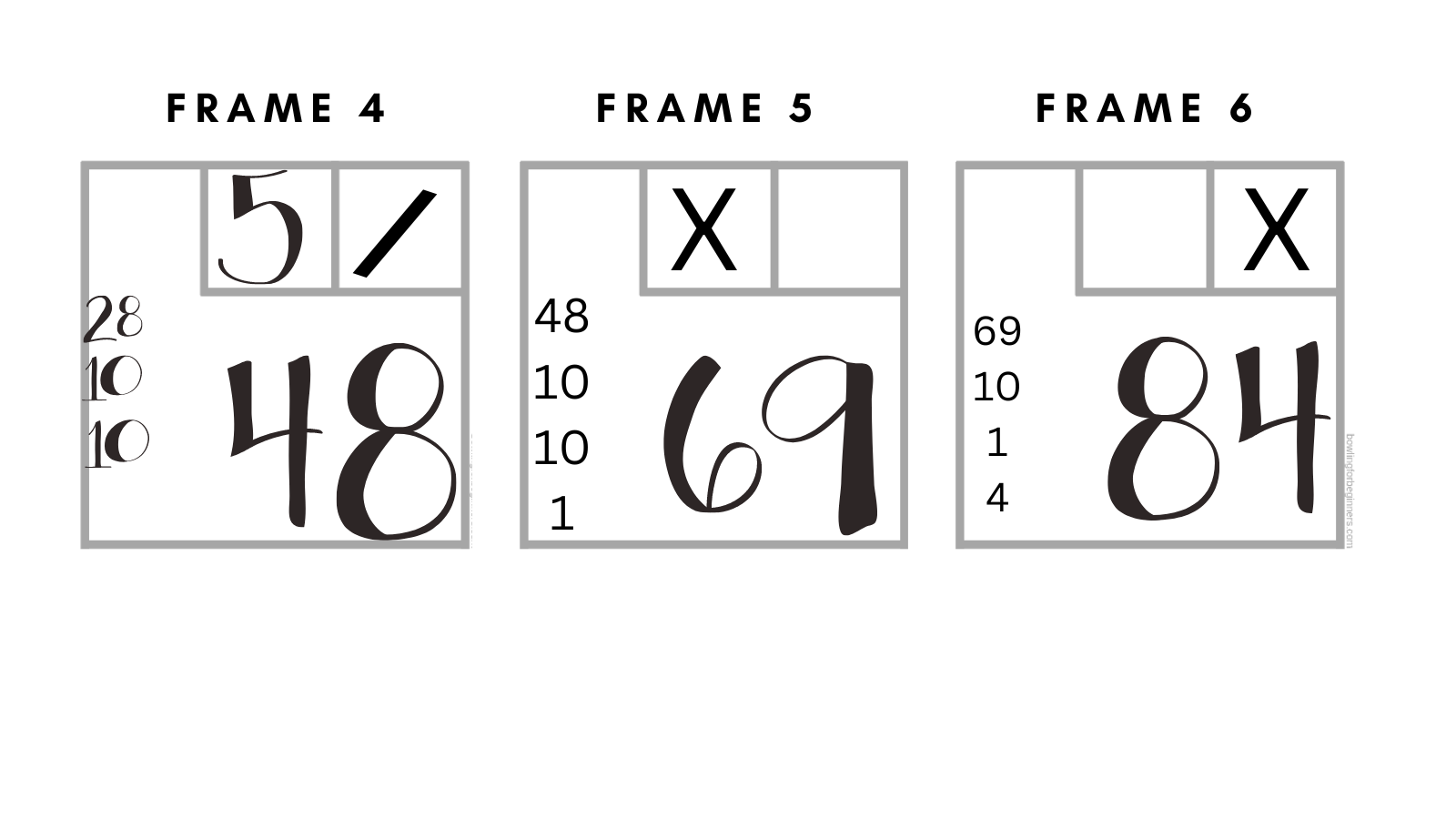
Finally, we can calculate Frame 7's points:
Frame 6 (84)+ Frame 7 (1) and (4)= 89 points for Frame 7
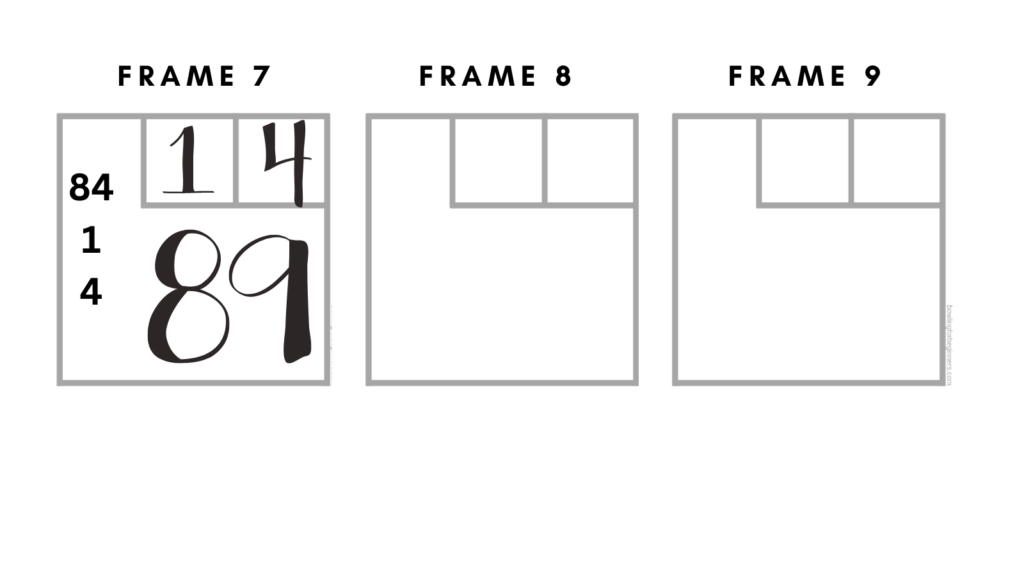
Frame 8:
In Frame 8, you knocked down 9 pins on roll 1, and an '-' or dash appeared on the screen after your 2nd ball, but you didn't hit anything.
What Does '-' Mean In Bowling?
In bowling, the dash or '-' can mean one of two things. A gutter or missing pins.
How Do You Score '-' In Bowling
Essentially, you get a 0. You scored no new points for that throw.
This is what happens when your ball falls off the lane into one of the side gutters on each side of the lane, and sadly, they are worth no points.
Sometimes even if you roll straight as an arrow, and you still miss the pin, like, you hit nothing, you only earn points from one roll. Additionally, you'll see a ‘-‘ mark on your scorecard.
Frame 7 (89) + 9+ 0 = 98 points for frame 8
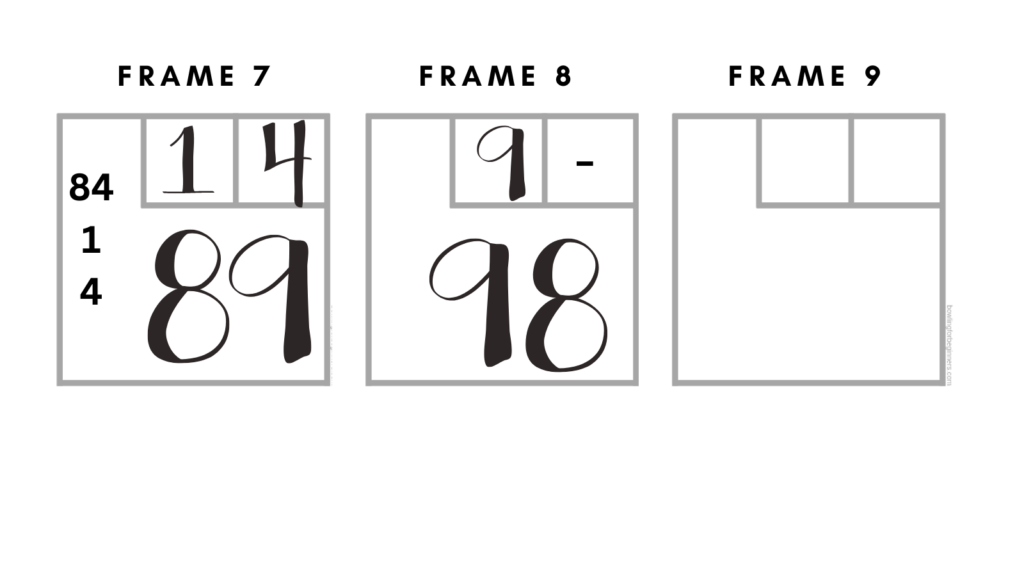
Frame 9:
In Frame 9, you knocked down 3 pins, then 2 pins. The next frame is the last frame.
Here's the calculation for the 9th frame:
Frame 8 (98) + Frame 9 (3+2)= 103 pins knocked down for Frame 9
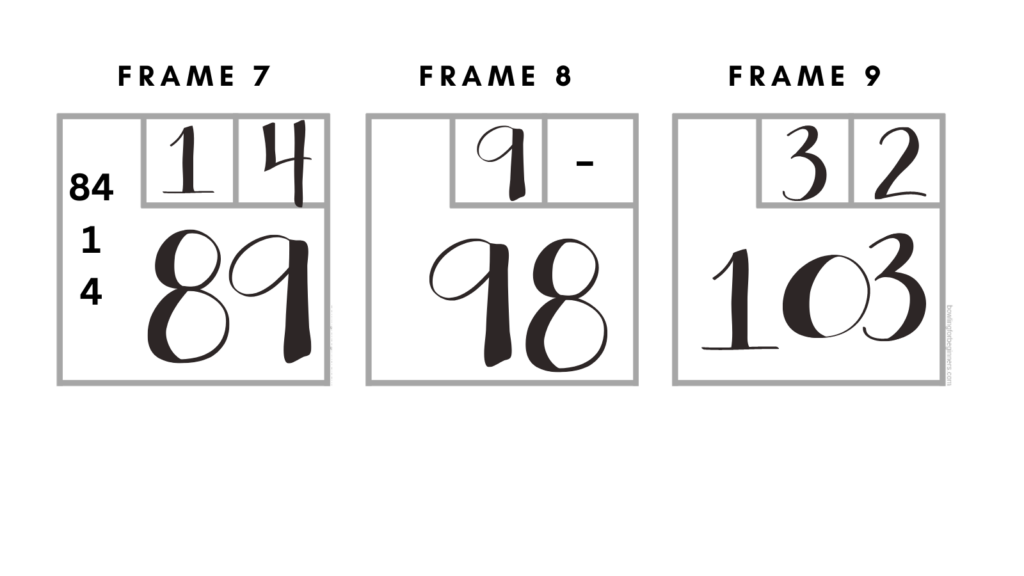
Frame 10:
Unlike the previous frames, you only rolled twice. The tenth frame is the only exception. In the tenth frame, you have a chance to roll 3 times.
In the tenth and final frame, your first roll is a strike, knocking down all ten pins. In the 10th, you don't get bonus points for strikes, but you do get a chance to roll again.
On your second roll, you rolled another strike. Because you threw a strike on your second roll in the 10th frame, you get a third shot.
On roll 3, you rolled a 3rd strike.
This makes 3 strikes in a row!
What is it called when you roll three strikes in a row?
In bowling, 3 consecutive strikes are called a Turkey.
How Many Points Are 3 Strikes In a Row?
Similar to Doubles, where you’re adding 20 points, when three consecutive strikes are scored, you get 30 points.
It should also be noted that 30 is the highest score possible for any frame. Even if you continue to get more consecutive strikes after your turkey, they do not count toward the first frame with the turkey.
30 points is the maximum per frame.
Frame 9 (103) + Frame 10 (10+10+10)= 133 points for Frame 10
Great job! You bowled a 133- that’s a great score for a beginner bowler.
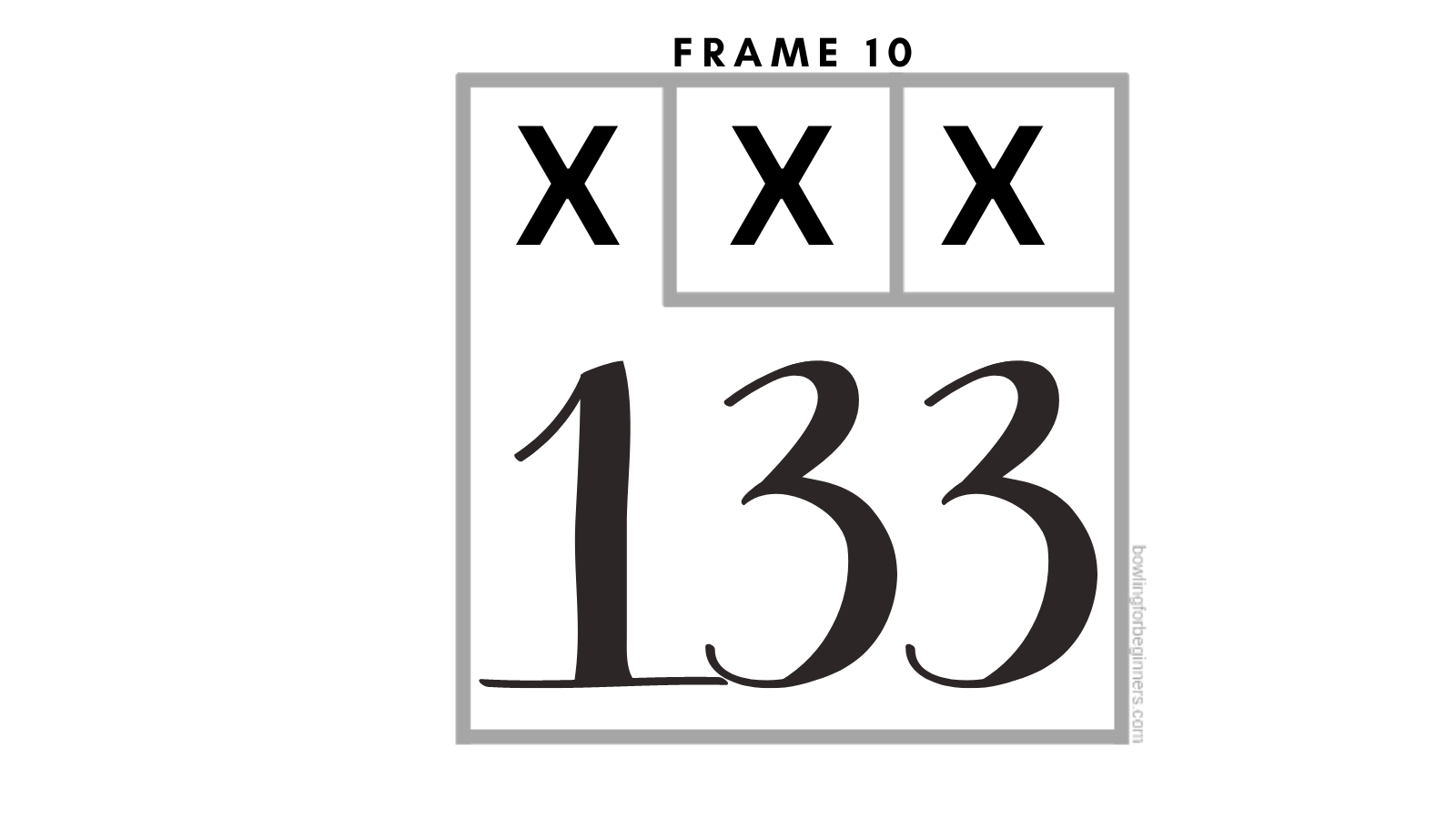
| Frame Type | Symbol | Scoring | Notes |
|---|---|---|---|
| Open Frame | None | Sum of pins knocked down | Example: 6 pins + 2 pins = 8 points |
| Strike | X | 10 points + pins from next two rolls | Leads to increased scores in subsequent frames |
| Spare | / | 10 points + pins from next roll | Crucial for adding bonus points |
| Double (Two Strikes in a Row) | XX | 20 points + pins from next two rolls of the double | Increases frame total significantly |
| Turkey (Three Strikes in a Row) | XXX | 30 points (maximum for a frame) | Highest scoring potential in a single frame |
| Gutter Ball | - | 0 points | No pins knocked down |
| Tenth Frame Special | X or / | Up to 3 rolls allowed | Extra chance for strikes/spares to add to score |
How to Score In Bowling For Dummies
1. Scoring Rules For Individual Frames
(i). Understand the parts of the bowling scorecard.
A column of vacant spots on the far-left border of the bowing scorecard allows you to write the names of each participant who is participating in the game. There are ten scorecard frames to the right of the names. The score of a single turn frame is added to each frame.
(ii). Use the scorecard frame that corresponds to the turn you’re taking.
A number appears above each column of scorecard frames. Starting with "1" and ascending (going up) to "10," this sequence is read from left to right. Add up each player's score on the scorecard for the frame they're bowling.
(iii). Write the score for the first roll in the upper left box for that turn
In each round, each player receives two chances to bowl unless they get all the pins down with their first ball in the last (tenth) frame. If they strike on their first roll, it's the next player's turn.
In each game, each player will bowl a maximum of 21 times.
It's critical that you keep track of each of these rolls separately, so write down how many pins you knocked down on your first roll in the upper left box.
(iv). Write the second roll’s score in the upper right-hand box for that turn.
Add that number to your scorecard once you've rolled a second time. Make sure to record only the number of pins you knocked down on your second roll, not the total number of pins you knocked down for the turn.
(v). Write an “X” in a small box in the top-right of the scorecard frame to indicate a strike.
In your first roll, a strike means you knocked down all 10 pins. While the small box in the top-right corner of the scorecard frame is usually allocated for storing information related to your turn's second roll, the strike is an exception.
(vi). Place a forward slash in the small box in the top-right corner of the scorecard frame to indicate a spare
A forward slash (a line linking the bottom left corner of the box in the upper right) shows that you didn't knock down all the pins on the first roll but did on the second.
(vii). Mark a foul by writing an “F”
Place an "F" in the upper center box if you step past the foul line (the line beyond which a bowler cannot step) on your first roll for that turn. Place a "F" in the little box in the upper right of the scorecard frame if you step past the foul line on your second roll for that turn.
If you foul on your first roll of the turn, you can still roll again.
(viii). Mark the scorecard with a dash if you miss the pins
A horizontal dash (-) indicates a miss if your ball slides into the gutter or if you otherwise miss the pins.
2. Tallying Your Score Between Turns
(i). Add the total number of pins knocked down in your 2 rolls when your turn is complete
For example, if your current score is 30 and the numbers at the top of the scorecard frame you just finished are 5 and 4, you would multiply 30 by 9 (5+4). Then your current score would be 39.
(ii). Score a spare by adding 10 to the number of pins knocked down on the next roll.
When you knock down the remaining pins on the second roll of your turn, you get a spare. You've scored a spare if you knock down 1 pin on your first roll and 9 pins on your second roll. Depending on how much you earn on the next roll, a spare can be valued anywhere from 10 to 20 points. You'd have to make a strike on your next roll to collect the maximum score.
(iii). Score a strike by adding 10 to the sum of the next turn
A strike occurs when all of the pins are knocked down on the first roll of the turn. Depending on how you roll after the initial strike, a strike can be valued anywhere from 10 to 30 points.
3. Calculating Your Final Score
(i). Only use the upper-right corner box in the 10th turn if you roll a spare or a strike.
The "fill box" is the third box in the tenth turn, and it helps you figure out how much your spare or strike will be worth if you roll one in the tenth turn.
(ii). Determine the winner by comparing the final score of the 10th frame
For example, you've won the game if your 10th-frame score is 110 and your friend's is 100. Congratulations!
(iii). Try to get as close to 300 as possible
In bowling, a perfect score of 300 indicates you hit a strike in all ten frames. While few players are that good, work on your bowling skills to come as close to perfection as possible!
What Is an Open Frame and How Is It Calculated?
If a bowler knocks down only a few pins with both of their rolls, the frame is called an open frame.
The amount of pins you knocked down equals the value of an open frame. 7+2=9. You've increased your total to 46 by adding 37 to it.
Frequently Asked Questions Related to How Is Bowling Scored
What Is A Perfect Score In Bowling?

A perfect score in bowling is 300.
Bowing a 300 is huge! And getting a perfect score in bowling, it's not as hard as you think. The hard part is bowling 300 consistently. In this guide, we share how many strikes are in a 300 game, how to calculate the perfect score, and how to improve your chances of bowling a perfect game.
How Many Points Is A Spare In Bowling?

A spare in bowling is worth 10 points plus the points from your next roll.
Have you wondered why having a strong spare game is important? The most important reason is to you in the game. But the real question is, do you know what to look out for? As always, we've done the heavy lifting for you and made it plain and simple what you need to know for a solid spare game.
How To Score A Strike In Bowling?
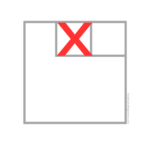
You score a strike in bowling by knocking down all the pins on your first roll and from your next two rolls after the strike.
The real question should be, do you the basics of what you to do for a strike? Like, what type of ball to use, do you need a 4 or 5 step approach, and where exactly do you aim the bowling ball? If you said no to any of these questions, we got you. Our article on How To Get A Strike gives you the basics of getting a strike.
Related Articles
Mastering the ten pin bowling scoring system is crucial for players aiming to enhance their performance in casual and competitive bowling events. With a focus on the strategy of the game, it's essential to understand how each frame contributes to your frame total, especially in the first nine frames, where setting up for strikes and spares can significantly impact your ability to knock down all ten pins. In a bowling center, whether you're playing solo or aiming for a higher team score against other teams, the ability to accurately score, including managing strikes (aiming for the elusive twelve strikes for a perfect game), spares, and understanding the critical tenth frame rules, sets apart novice players from professional bowlers.
Remember, every pin counts; clearing the remaining nine pins to the last four pins will add points to your score. Every roll is an opportunity to improve your game and outscore the competition.
Kira Byrd, a Certified Fraud Examiner, holds a B.S. in Accounting from the University of Alabama at Birmingham. With a passion for bowling from her childhood, Kira has poured her expertise and personal experiences into creating and nurturing Bowling For Beginners. Kira's mission is to meet new bowlers where they are and guide them toward consistently achieving higher scores. With a focus on skill development and strategic techniques, she empowers readers to take control of their game and unlock their true potential.
Bowling For Beginners embodies strict editorial integrity, ensuring reliable and unbiased information. Kira's commitment to delivering valuable insights and practical strategies is reflected in every article. Here's an explanation of our editorial policy and how we get money.





